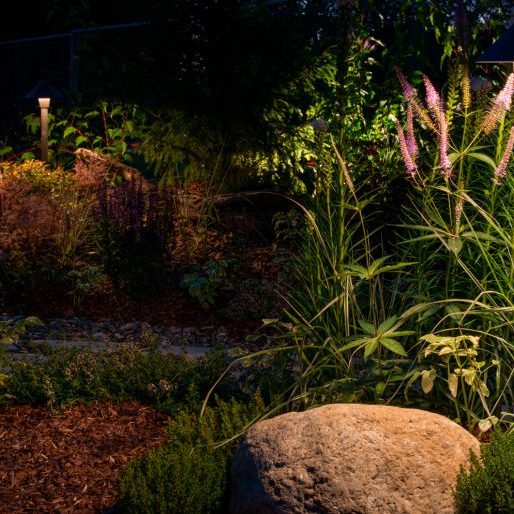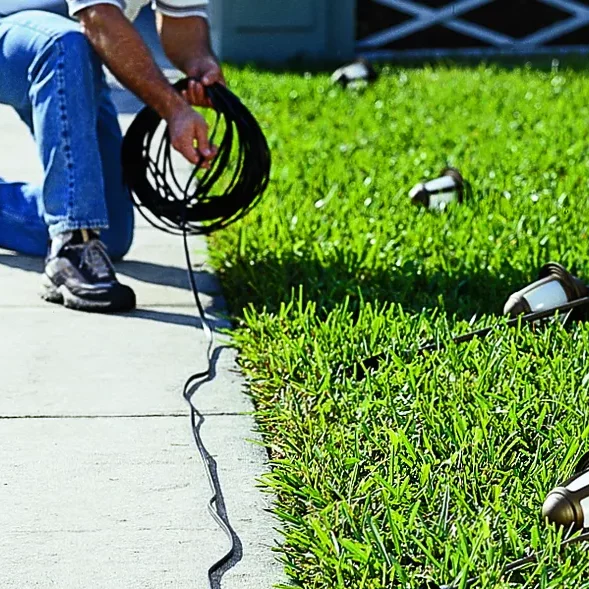Read this step-by-step guide to learn how to light up your path with quality landscape lighting in your garden.
Enhance the nighttime curb appeal of your home—and add a measure of safety and security—with low-voltage landscape lighting. These exterior-grade fixtures are typically placed along walkways and driveways, but they're also ideal for illuminating steps, trees, stonewalls, fences, and other prominent landscape features. And because the system operates on only 12 volts of electricity, it's completely safe for do-it-yourself installation.
At the stately 1930s-something home shown here, we installed 12 Intermatic fixtures in three different areas. Alongside the walkway leading to the entryway are six decorative aluminum fixtures that have a curved shepherd's hook profile. Two 20-watt wall-wash fixtures are used to illuminate the white-painted lattice fence on either side of the walkway. At the base of each of the four evergreen shrubs growing against the house is a 20-watt shrub uplight. The 12 fixtures are connected with a 12-gauge cable and powered by a 300-watt transformer.
Step 1: Landscape Lighting Overview

Low-voltage landscape lighting is a simple improvement that can make a huge difference in how your home looks after dusk and in its safety and security as well. Installed along walkways, steps, and driveways, or pointing up at trees, walls, and fences, the typical low-voltage lighting system requires just three components: a transformer, low-voltage electrical cable, and the fixtures. You don't have to be comfortable with wiring—or even have ever done any—to install this type of system.
The transformer steps down the 120-volt house current to just 12 volts. It must be plugged into a GFCI-protected outdoor electrical outlet fitted with a "while-in-use" cover, and oversize plastic box that closes over the power cord. The transformer needs to have enough capacity to support the cumulative wattage of the lights in the system. Between fixtures, the cable is buried in a shallow trench. As long as you have a nearby outlet, you'll be able to give your home and yard a welcoming glow when the sun goes down.
Step 2: Lay out the Components

Set the pathway light fixtures on the ground where they'll be installed — usually about 8 to 10 feet apart.
Lay the low-voltage cable along the concrete walkway, following the line of light fixtures. Use 14-gauge cable for lighting systems that total 200 watts or less and 12-gauge cable for systems that are more than 200 watts.
When you come to an obstacle, such as a fence or shrub, string the cable under or around it.
Tip: Put first fixture at least 10 feet from the transformer.
Step 3: Turn over the Sod

Move the light fixtures out of the way.
Take a flat-blade shovel and slide it underneath the top layer of grass, about 12 inches in from the edge of the walk. Then lift up on the handle to separate the grass from the soil, and fold over this scalped portion of sod. Continue in this manner all along the walkway.
Use the corner of the shovel's blade to scratch a 3-inch-deep trench in the soil where the wire will go.
Tip: If necessary, set the light fixtures on top of the folded sod to prevent it from flopping back down.
Step 4: Bury the Electrical Cable

Set the low-voltage electrical cable in the trench. Leave a bit of slacked cable at each fixture point for making the connection to the light fixtures.
Smooth the soil over the trench, but leave the cable sticking up out of the soil near each fixture.
Make a slit in the detached sod where the fixture will sit and fold the sod back over the soil, keeping the cable for each fixture above the grass.
Tip: Don't bury the cable more than 3 inches or you'll have difficulty connecting the light fixture.
Step 5: Plug in the Transformer

Run the cable up to the outdoor electrical outlet. Then use wire strippers to cut the cable and strip off ½ inch of the rubber insulation.
Slide the stripped wires under the two terminal screws on the bottom of the transformer. Tighten the screws all the way to hold the cable securely in place.
Drive a wood stake into the ground next to the outlet. Then screw the transformer to the stake. (It can also be mounted directly to the wall of the house.)
Lift up the "while-in-use" cover on the outlet and plug in the transformer.
Step 6: Prepare Holes for the Fixtures

Set all the light fixtures back into position, checking to make sure they're equally spaced.
Position the first fixture as close to the edge of the walkway as possible without any part of it hanging over. (If the fixture extends into the walkway, people will constantly be bumping into it.)
Make a hole in the ground for the fixture's stake with a large screwdriver or long steel punch. Never use a hammer to drive the fixture into the ground.
Tip: Don't place a light within 10 feet of a pool, spa, or fountain.
Step 7: Make the Electrical Connections

Slip the two connector halves hanging from the bottom of the light fixture over the cable that's protruding from the sod and pinch them together until you hear a click. This allows the sharp prongs inside the connectors to pierce the cable and make contact with the wires inside.
Since the transformer is plugged in, the fixture should light up, confirming the connection is good. If it doesn't, unsnap and re snap the connector, or check the bulb.
Tip: If none of the bulbs lights up, you may have a faulty transformer or outdoor electrical outlet.
Step 8: Install the Light Fixtures

Insert the light fixture into its metal ground stake.
Using both hands, push the fixture and its stake into the ground until the top of the stake is flush with the ground. Eyeball the fixture to make sure it's not tilted to one side.
Tuck the cable and connector under the sod and stuff them into the soil, about 2 inches deep.
Continue installing the remaining fixtures in the same manner.
Step 9: Replace the Sod

Once all the light fixtures are installed and working properly, smooth out the sod around the fixtures.
If necessary, cut the sod around the light fixtures with the shovel.
Плотно прижмите дерн, затем смойте участок водой из садового шланга.
Tip: In regular use, promptly replace a burned-out bulb or it will shorten the life of the other bulbs.
Popular items you might be interested in:
Useful materials

Principles and concept of lighting installation


















